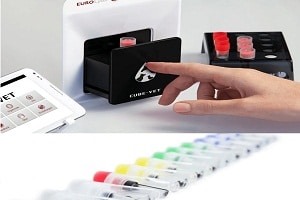Without testing, it’s easy to miss a dog’s fertile window. Using dog ovulation tests to determine the best time to breed can result in a successful pregnancy.

If you’re looking for ways to increase the pregnancy chances of your dogs, keep reading. This article discusses ovulation testing in dogs and the effective timing of ovulation.
Ovulation Timing
Female dogs go through the estrous cycle, or heat cycle, twice a year. This stage lasts about three to four weeks and includes the days your dog will ovulate.
The ovulation cycle in female dogs is an important factor to consider when planning to breed. Knowledge of the canine estrous cycle, awareness of female dog’s hormonal changes, and appreciation of pregnancy tests increase the chances of conception.
When it comes to breeding, ovulation timing is important because it allows you to establish the best time for conception. Breeding timing can also assist you in figuring out when your dog may give birth.
Knowing when the dog may give birth is also important because you want to prepare for the whelping, including the warm and comfortable environment in which the puppies may grow and be cared for by their mother.
Canine Ovulation Period
Ovulation tests are important in determining the most fertile days of your dogs, which usually begin after the proestrus stage and at the outset of the estrus stage of their heat cycle.
The heat cycle composes of two basic stages: proestrus and estrus stages. Each of these stages lasts for about 9 days.
● Proestrus. Hormonal changes start. Your dog will have bloody discharge and swelling vulva, among others. However, it will not be receptive to male dogs’ attention.
● Estrus. The ovulation period happens at this stage and your dog will be receptive to male dogs’ attention.
Each heat, dogs frequently follow the same routine. Keeping track of each heat, even if you aren’t breeding, will help you prepare for when you’re ready to breed. The length of estrus is used as a general guideline to determine when progesterone levels start to go up.
Progesterone is one of the female dogs’ reproductive hormones that play an important role in their ovulation.
Testing should start at the beginning of the heat cycle to monitor estrogen and progesterone levels. Ovulation starts about 48 hours after the increase in LH or Luteinizing Hormone. The most fertile period is believed to be Day 4 through Day 6 from the start of the LH surge.
Please note that there may be some variation in heat cycles, depending on the breed and the size of your dog.
Canine Progesterone Analyzers & Tests
In female dog reproductive, progesterone testing is an extremely useful, affordable, and easily available tool. It can be employed at various points of the reproductive cycle to provide information on when to mate.
For beginners, taking note of your dogs’ progesterone levels will suffice. The most precise method for timing breedings is a quantitative progesterone blood test. The test yields a numerical result, usually in the range of ng/ml.
Progesterone baseline before the LH surge is in the 4-8 nanograms-per-milliliter range. By the time the bitch ovulates, it will be greater than 20 nanograms per milliliter (often 30-40 ng/ml) range.
Ready to Test?
Assuming there is no issue with semen quality, mating your dogs when ovulation occurs will result in a successful pregnancy. If you use dog ovulation tests for your female dogs, you can accurately pinpoint the fertile window and predict ovulation.
So if you’re ready to test your dog, visit MR Diagnostic Services and browse through their collection of progesterone analyzers.
Getting your own ovulation test kits is always more cost-effective than sending your dogs to laboratories, particularly for breeders, vets, and researchers. Drop by their site today
For more information about Progesterone Test For Dogs and Canine Sperm Analysis Please visit: MR Diagnostic Services.
Hi, I am Adam Smith, Admin Of TechSketcher, Creative blogger and Digital Marketer.